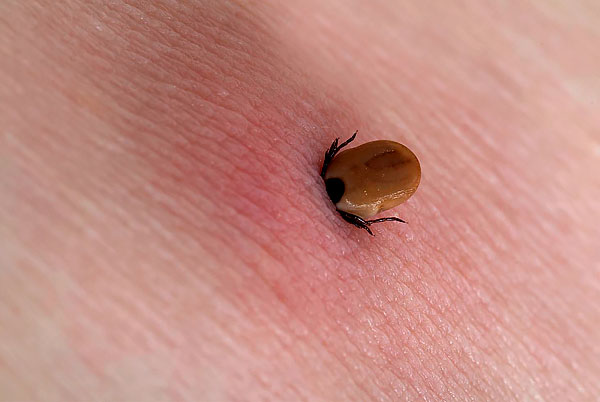
The desire of a person to pull out a sucked tick from the skin as soon as possible is quite natural and understandable - with saliva, the parasite can introduce dangerous infections into the blood, and the longer the blood sucking continues, the more infectious agents can be injected into the wound. And, unfortunately, it often happens that an unprepared person, having discovered a parasite in himself, tries to immediately remove it with his fingers, simply by tearing it off the skin. However, brute force in this case will not lead to anything good.
The fact is that the tick is fixed in the skin very securely. Studies have shown that after the start of bloodsucking, a special capsule of hardened saliva is formed around its head, which helps the arthropod to stay in the skin and prevents its extraction. That is why it is not so easy to simply remove the parasite - often the tick is held in the integument of the human body so tightly that when trying to remove it, its body simply comes off the head.
This situation can be dangerous: saliva (possibly infected) remains in the head of the parasite, which continues to flow into the wound. This may increase the risk of contracting tick-borne encephalitis or other ixodid-borne diseases.And the tissues in the place where the fragment of the parasite remains can become inflamed with subsequent suppuration.
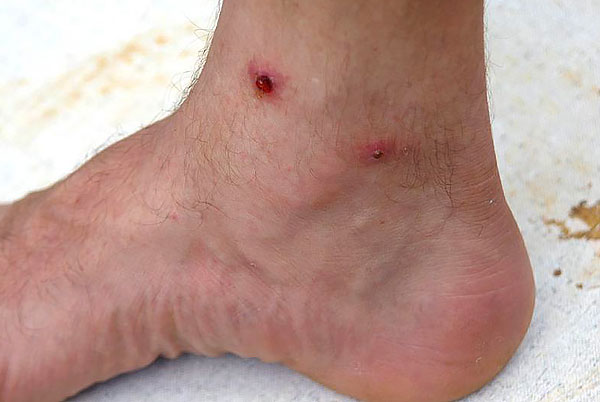
At the same time, it would be wrong to simply leave a tick in the skin, hoping that it will suck blood and fall off on its own. In this case, the risk of infection is significantly increased, since as the parasite sucks blood, it constantly introduces new portions of saliva into the blood vessel. And the process of bloodsucking can last several days.
This means that the tick must be removed quickly and at the same time correctly - so that its head or proboscis that comes off does not remain in the skin. About how to do this in the best way, we will go on and talk in more detail ...
The most common mistakes: how not to remove the parasite from the skin
The most common and obvious mistake when extracting a tick is simply trying to grab its torso with two fingers and tear it off the skin. It is this action that is most likely to lead to separation of the body from the head. And if the tick has already sucked out a lot of blood, then such removal may be accompanied by squeezing blood from its stomach back under the skin - this increases the risk of infection.
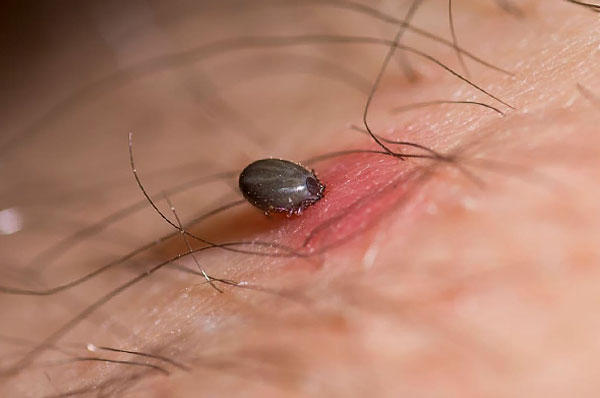
Meanwhile, many people understand that it is impossible to simply try to tear the tick off the skin. And often other methods are used, which are also ineffective. Such methods include, for example:
- Pour vegetable oil on the tick - it is assumed that the oil, enveloping the head of the parasite, blocks the access of oxygen to it and leads to suffocation. As a result, the bloodsucker allegedly tries to get out of the wound himself.In reality, this will not happen in most cases: the peritremes with spiracles in ticks are located on the sides of the abdomen, and not in the head, and the parasite will be able to breathe, even if there is oil at the site of contact with the skin. And even if the whole body of the parasite is abundantly covered with oil, it will really suffocate, but this can happen much earlier than it has time to detach itself from the skin;
- Drop gasoline, vinegar, alcohol on the tick, or even more sophisticated - pierce it with a needle from a syringe and inject hydrogen peroxide into its body. In these cases, the parasite may die before pulling the head out of the wound;
- Cauterize the tick with a match or a red-hot needle - the result will be similar to the previous one.
In order not to make such mistakes and not lose precious time, you need to understand that a tick, having not yet been fed, is unlikely to detach itself, even if there is a risk of injury and death. Therefore, trying to somehow “motivate” him to unhook is almost useless.
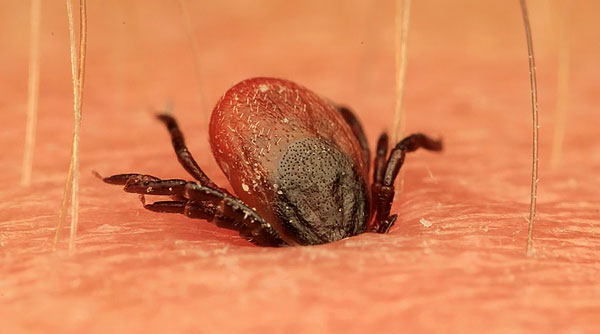
It is interesting
Blood sucking is a critical and rather long process in the life cycle of the tick. It is during nutrition that some internal organs of the arthropod develop and reach maturity, the final formation of the intestine occurs, and previously inactive processes in the body are fully launched. If at this moment the tick unhooks from the host, then with a high probability it will not find a new one and will die. Therefore, the behavioral model of avoiding various external stimuli during feeding has “turned off” in these parasites. That is, even if injured, the tick is more likely to remain where it stuck, rather than unhook it on its own.
Also, any ways to remove a tick are not correct if they initially involve tearing off the head (for example, cutting it off with a knife or scissors). In this case, additional manipulations will be required to remove the oral organs of the parasite from the skin.
In fact, pulling out a tick means removing its head from the skin, even if it is not connected to the body. However, while the parasite is intact, it is easier to do this. Therefore, the correct removal of it is such that:
- The tick is removed as quickly as possible - within a few minutes after detection. You do not need to go to the hospital for this or expect to remove the parasite without fail at home upon returning from a picnic or fishing - it must be removed where the person found it on himself;
- The body of the parasite is not compressed;
- The oral organs of the arthropod do not remain in the skin at the site of the bite.
There are several methods that meet these criteria for extracting a stuck tick from the skin. Let's look at them in more detail.
Special tools for removing ticks
All special tools that allow you to safely get a tick work according to a similar principle: the body of the parasite is captured at the place of its articulation with the head (close to the skin) and fixed in a special groove of the device. After that, the device gently rotates, as a result of which the fixation of the hypostome (oral apparatus) in the skin weakens, and after several revolutions the parasite is safely removed.
In the simplest case, the device looks like this:

In various stores, such a device may be called Tick Twister, Tick Twister, Tick Extractor, or something else.The photo below shows how to capture a parasite with such a hook:

After capturing the parasite, it is enough to take hold of the handle with your fingers and make several turns in one direction so that the tick falls out of the wound.
The main disadvantage of such an extractor is that, like any auxiliary devices, it is usually forgotten at home, in a car or in a tent, and at the most necessary moment it is not at hand. Therefore, it is useful to know how you can make such a tool yourself. For this you need:
- Take a strong stick about 1 cm thick;
- With a knife, make an oblique cut about 1-1.5 cm long at one end;
- At the bottom of the cut, cut a groove about 1 cm deep.
Such a device is somewhat more difficult to use than an industrial-made pliers, but if you get used to it, you can work with it as quickly and efficiently as with a purchased device. At the same time, it will always be possible to make it in nature with your own hands. This is actively used by tourists and supporters of autonomous survival.
Due to the high seasonal demand for such devices, many of their modifications are produced, working on a similar principle:
- The same extractor, only small and attached to a bunch of keys in the form of a keychain. It's called Trixie. Convenient because, for example, on walks in the city, he is always with him;

- Special Tick Key with tick grip. Its advantage is compactness and the ability to carry in a wallet;

- Rare commercially available Groom Professional Tick Remover that captures the tick just like the Tick Key;

- Special paddle Ticked Off;

- Tick Nipper - a kind of pliers with which you can grab and remove the tick even without rotation;

- The Pro-Tick tick remover, very compact and most similar in principle to a homemade stick extractor;

- Special Tick Remover tweezers in the form of a pen, allowing you to control the grip of the parasite and easily rotate it until it is removed;

- The Russian-made Anti-Mite wire extractor is a compact and simple device, which, however, requires some skill for successful operation.

By and large, instead of all these devices, you can use simple tweezers or tweezers from a manicure set. Small parasite nymphs can similarly be removed with a cotton swab - their body is simply turned with cotton wool in one direction until the head comes out of the skin.
Using thread to extract the parasite
Also known is a method of removing a tick with a thread. Its principle is the same as that of the tools discussed above, but it is good in that it can be implemented anywhere and at any time, since the thread to extract the tick can be pulled out of clothes, towels or any other textile product.
The sequence of actions is as follows:
- A simple knot is knitted in the center of the thread, but is not tightened to the end;
- The loop is thrown onto the tick and tightened so that it wraps around the junction of the head and body as close as possible to the surface of the skin;
- The ends of the thread are folded together, pinched between the fingers, pulled, but not too tight, so as not to accidentally pull out the tick;
- With a rubbing motion of the fingers, the ends of the thread are braided around each other so that when twisted, they begin to rotate the tick. After a few turns, it will fall out of the wound.
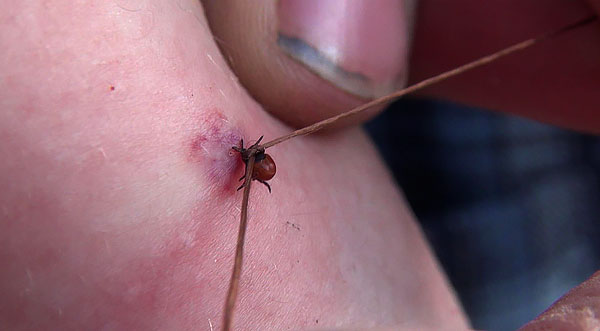
The main disadvantage of this method is the difficulty of pulling out the attached parasite from oneself, especially if it is necessary to look in the mirror (if the tick, for example, stuck to the head) or remove the bloodsucker from the hand near the wrist. It is most convenient to use the thread when one person is helping another.
In addition, in this case, accuracy of actions and great accuracy are required, which is not always available to a person who is terribly afraid of ticks. Nevertheless, the method is quite effective and can be adopted by tourists and outdoor enthusiasts.
Removal with bare hands
Finally, the tick can be removed from the skin with bare hands. This is possible if the parasite is large and, moreover, has managed to suck a large amount of blood, due to which it has increased in size (then it can be conveniently grabbed with your fingers).
In this case, the body of the arthropod is grasped, but not squeezed, and rotates in one direction. It doesn’t matter in which direction to rotate - 3-4 turns are enough for the bloodsucker to stop holding in the wound. After that, when rotating, it simply falls out of the skin.
The disadvantage of this option is the impossibility of removing small nymphs, especially those that have just sucked, which are difficult to capture with fingers. Also in this case, there is a high risk of squeezing the contents of the tick into the wound or tearing off the head - after all, one has to grab the parasite by the body filled with blood (in contrast to the cases of using special tools that allow one to capture the parasite under the body, that is, at the place where the head is articulated with the body).
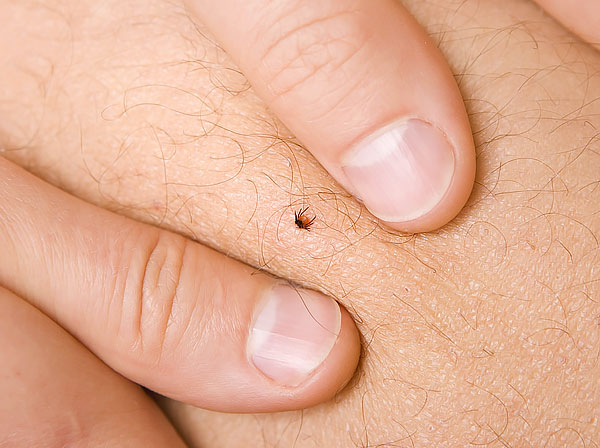
Nevertheless, the experience of many tourists and hunters shows that with a certain skill this method is very effective.
A few words about removing the parasite with a vacuum (using a syringe)
There is an opinion that the tick can be removed with a syringe. Allegedly, if you cut off the upper part with a cone tip from the syringe, slightly raise the piston, attach the cylinder with the cut edge to the bite site so that the parasite is inside it, and the edges of the cylinder are pressed tightly against the skin, then by pulling the piston, you can use the vacuum literally "suck" the tick out of the skin.
In fact, this method can hardly be considered a working one. In practice, the vacuum that is formed in the syringe, in most cases, is not enough to remove a firmly attached parasite.
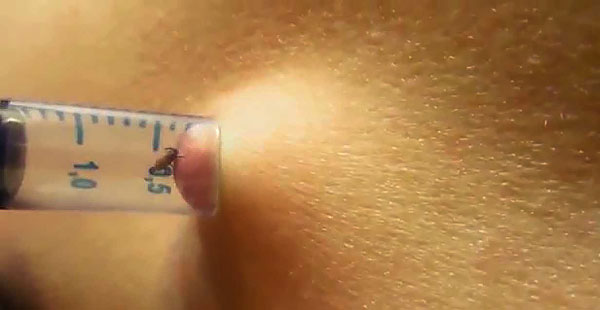
In addition, when attempting such a removal, edema is formed on the skin area, which is drawn into the syringe barrel - this area becomes burgundy. Increased blood supply in an infected wound will only lead to an accelerated spread of the infection throughout the body.
And the syringe itself is unlikely to be at hand where the parasite will attack a person. Therefore, it is not worth considering this method as effective and relying on it.
On a note
It should also be borne in mind that the principle of removing a tick with a syringe involves creating a vacuum around its body. If you create such a vacuum several times, and then drop it to atmospheric pressure, then this will be equivalent to squeezing the contents of the tick into the wound.
What to do if the head or proboscis of the tick remains in the skin
And yet, situations where the victim prefers not to bother using complex tools and decides to simply pull the tick out of the skin happen all the time.As a result, it often happens that the body of the tick breaks away from the head with the mouthparts remaining immersed in the skin.
What to do if such a nuisance occurs?
Firstly, you don’t need to worry much about this - this is not a catastrophic case, the likelihood of serious consequences is small, and it’s not difficult to get rid of the head of the tick remaining in the skin.
Secondly, the remains of the parasite must be removed. You need to pull them out in the same way as an ordinary splinter is removed from the skin: with a disinfected needle or nail scissors, you need to pry off the head and pull it up. If necessary, the edges of the wound can be slightly expanded. It's painful, but tolerable.
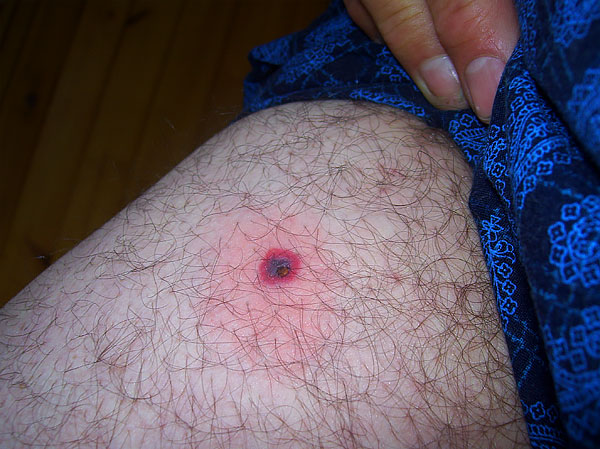
Even before removing the head, you need to lubricate the wound with an antiseptic - for example, alcohol, hydrogen peroxide, a pencil or chlorhexidine. It is not recommended to immediately smear the wound with brilliant green or iodine, since then it will be difficult to find the place where the tick head is stuck in a large dark spot.
When the head has already been removed, it is useful to treat the wound again with an antiseptic (and here iodine or brilliant green can already come in handy).
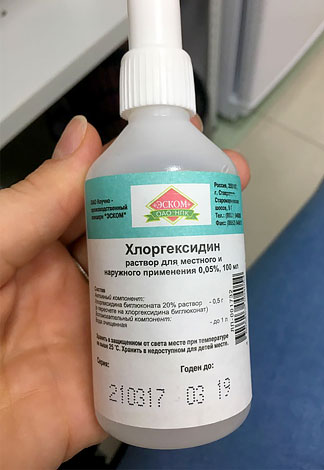
It is useful to keep in mind that nothing critical will happen even if the head of the tick remains in the skin. The wound suppurates, the abscess will break and the remains of the parasite will come out with pus. However, this is an undesirable option: the longer the mouthparts of the tick remain in the skin, the more saliva will enter the tissues and the higher the risk of infection with tick-borne encephalitis or borreliosis. Therefore, everything that could remain in the skin when trying to remove the parasite must be pulled out. Fortunately, this is done relatively simply and quickly.
What to do with the bite after removing the tick?
If the tick is removed quickly enough after sucking, when it has not yet had time to feed, then at the place of its attachment usually there are no strongly pronounced traces. If the parasite has already sucked out a lot of blood, then after its removal, a noticeable lump remains on the skin, which quickly smoothes out.
In all cases, the wound requires treatment:
- First of all, you need to treat with an antiseptic;
- Sometimes it also becomes necessary to lubricate the bite site with an anesthetic if pain, itching or pain is felt here. For this, simple ointments such as Menovazan, Relief Advance, Fenistila and their analogues are suitable.

Treatment with an anesthetic ointment often helps when the tick has been removed from the child, and a lump remains at the site of the bite. As a rule, such a blister is very itchy, and the child will involuntarily try to comb it. This can lead to secondary infection and suppuration of the wound. The ointment also relieves itching and pain, so that the child will not pay attention to the bite site.
The same is true for pets - dogs, cats, rabbits - they can comb the bumps to the blood.
Should I go to the hospital or emergency room?
It is logical to assume that the safest and most reliable way to remove a tick is to see a doctor. On the one hand, it is true: the specialist has all the necessary arsenal of tools for extracting the parasite, as well as effective medications that can be used to treat the wound.
On the other hand, removing a tick is a simple and quick procedure that anyone can perform in the same place where they found the parasite on themselves in less than a minute. Spending hours of time on a trip to the clinic and sitting in line for the sake of such a simple manipulation is irrational.

It should be borne in mind that the longer the infected tick remains in the skin, the more infectious agents it will have time to lead into the wound.
So, if a tick is found in the skin, you need to pull it out yourself, or ask a person nearby to do it. If the bite occurred in an epidemiologically dangerous area, then the extracted parasite must be preserved (for example, placed in some kind of tightly closed container) and already go to the clinic with it. There, the victim will undergo emergency prevention of tick-borne encephalitis, and then they will tell you where to take the tick for analysis.
On a note
It is possible to analyze a tick for infection with infection in almost any large city of the Russian Federation, including where tick-borne encephalitis is not common. Such an analysis is relatively simple and inexpensive (in Moscow it costs about 300-500 rubles). If it is not clear where to go, then Rospotrebnadzor will tell you where exactly the person needs to take the tick for research.
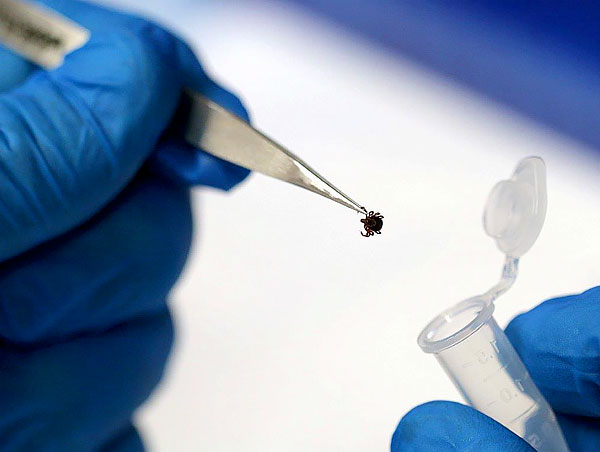
If the parasite has bitten where tick-borne encephalitis or borreliosis is not recorded, then it is enough to simply throw away the removed tick, remember or write down the date of the bite and observe the condition of the victim and the appearance of the skin around the wound for two weeks. If within 2-4 weeks the bitten person develops symptoms of infection, take appropriate measures, and if there are no signs of the disease, then you can no longer worry.
Removing a stuck tick with a thread

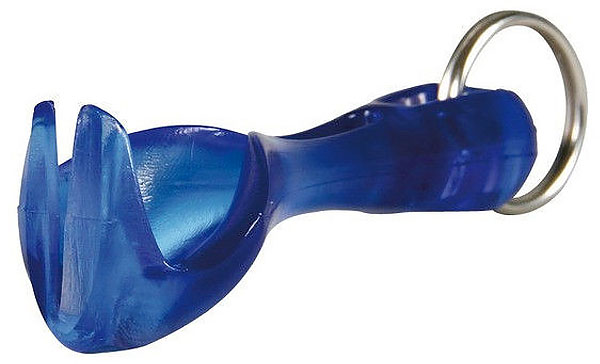

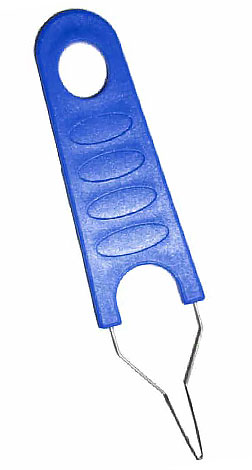




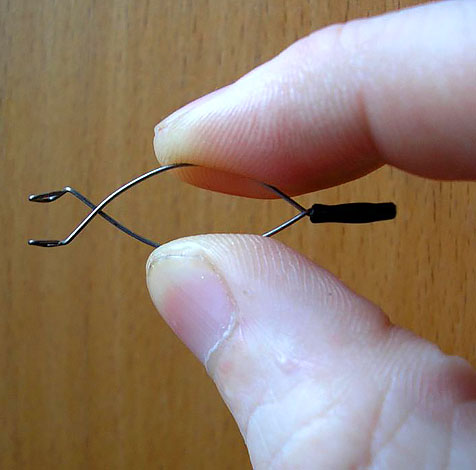
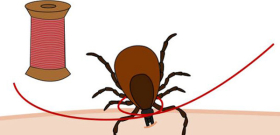

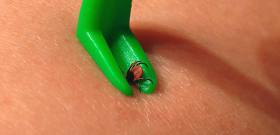
All the described methods of extracting a tick have one feature: damage to the tick is not ruled out. In addition, certain devices or materials are required. I extract ticks without any tools, and on my own from almost any part of the body.
I have not seen publications or reviews of friends about the use of this method. But I think experienced foresters came up with the same thing. The body of the tick has a shape close to spherical. This led me to the idea that you can just roll it like a ball, and this will create discomfort or pain for the tick at the transition from the torso to the head (that is, in the neck, which it may have).
The extraction process is very simple. You need to moisten your finger with water (it’s easier to just slobber - the same natural disinfection), press the tick very lightly and roll it in small circular motions like a small ball. This must be done patiently for 1-2 minutes, since this prehistoric insect does not have a quick reaction to external influences. The tick will fall off by itself, and remain alive and unharmed.Those who are squeamish about contact with a tick can wear a fingertip or a rubberized glove. But I have never used these attributes, although during my country life I find these cute creatures on myself with unenviable regularity.